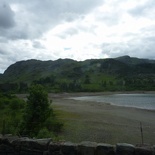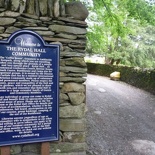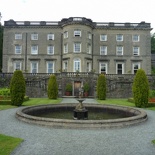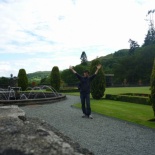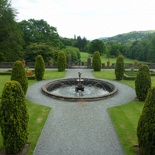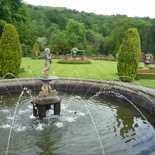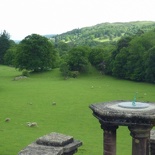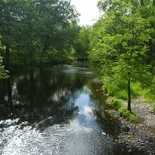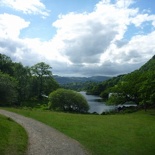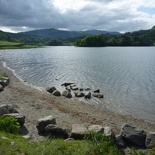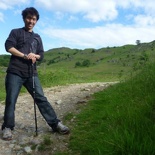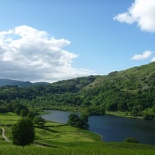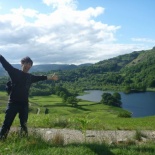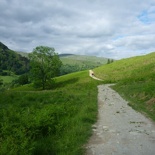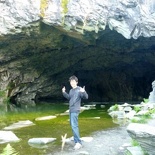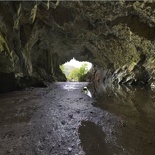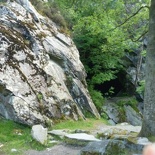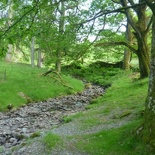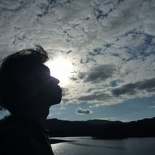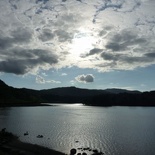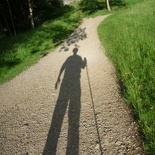Rydal is a small nature area close by are Grasmere to the north and Ambleside to the south-east. It is home to few interesting attractions, we have the Rydal water, which is an enclosed lake by a small wooded area overlooked by a fell, the Rydal hall and mount which are historical houses. You can stop by Rydal or the nearby town of Grasmere using the bus services plying between Keswick and Windermere along the A591, which was done on my visit.
Most of the attractions are situated along the roads, Rydal hall and mount is just a short northern walk uphill from the bustop along Rydal road. Essentially located near Ambleside, Rydal Mount is a house and is best known as the home of poet William Wordsworth from 1813 to his death in 1850. On a little background, Wordsworth was born in Cockermouth in Cumberland in 1770, the Lake District being his native childhood home. He moved away to study at the University of Cambridge in 1787, and then traveled in Britain and Europe for 12 years. He spent over 8 years at Dove Cottage in nearby Grasmere from 1799 to 1808, but was forced to move to accommodate his growing family and many visitors. After a period in Allan Bank in Grasmere, the Wordsworths moved to Rydal Mount in 1813. The building still stands today untouched by time.
Situated just opposite Rydal Mount, Rydal Hall is an early 19th century Grade II listed historic house on the outskirts of the village of Rydal. It used to be owned by the Le Fleming family. The house is now used for retreats, conferences, courses and holidays in a beautiful situation near Rydal Water, north of Lake Windermere. There are also formal gardens with a fountain and balustrades open to the public, with donations accepted and The Rambler’s Tea Shop, also known as The Old School Room Tea Shop open daily except Christmas. It is located centrally on the “Coffin Route” between Dove Cottage, home of Wordsworth before he moved to Rydal and Rydal Mount, with good views.
Both Grasmere and Windermere lakes can be seen from the hillside grounds of Rydal Mount. William Wordsworth designed the layout of the gardens at Rydal. The gardens, build on a hill incline essentially spots the main hall building overlooking the lush gardens itself, accessible by a 2 tiered stone staircase just a floor below the ground level. The spotlight of the gardens is a central fountain flanked by two nicely manicured lawns with flower beds, you can view a 360 degree panorama of the gardens below:
Wordsworth often frequented these gardens for work as opposed to the spacious office/writing room in his house. On the high side of the grounds, tucked away from the main house, but overlooking both the grounds and the two nearby lakes, he built the “Writing Hut” where he spent most of his writing time. This hut consisted merely of a bench with a small roof, but it provided shelter from the frequent rains and escape from the house. He lived the rest of his life there until his death at the age of 80, and he frequently was visited by Samuel Taylor Coleridge who would walk down from his home in Keswick.
From the gardens, you will be treated by lush views of the open plains by a stone sundial and with the Rydal peaks filling the horizon over the background. Just across Rydal mount is the Rydal water, or Rydal lake as we come to know about. The path to Rydal lake starts with a small entrance by the road side along Rydal road by a hostel and the Rydal Lodge Country house, bringing you across a small wooden bridge over a small river. This area across the road is also home to the Cote How organic Tearoom.
Armed with my trusty trekking stick, the trek to the lakes start here. The tranquility is awesome! With excellent weather to boot, I saw myself making my way from the open trail towards a wooded area. This forested area is really nicely shaded with several nice open areas to hold gatherings by the lake and enjoying the bank side views. There is a surprising lack of fishing activity on the lakes, as this will make a perfect fishing spot. It’s only where passing by a notice did I come to realize that you actually require a permit here to fish. Much to the relief of the wildlife here I guess.
In a nutshell, Rydal Water is essentially a small lake in the central region of the English Lake District, Cumbria. It’s location near the hamlet of Rydal, between Grasmere and Ambleside in the Rothay Valley can be seen passing on the main roads from Windermere. It is a popular recreational spot, with swimmers frequenting the lake and many joggers on the stone trails on my visit.
Tide levels are optimal, there are regular open areas in the forest running eastern of the water body, allowing you access the lake side, and busk by the banks over the shady forests, enjoying the nice reflective views of the water. The air here are fresh, dry and cool. A further trek west will bring you out of the shelter of the forest and into the sunny open stone trails by the lake. Here is a panorama of a view of the lake by the banks taken from the stone trail.
The bank views are wicked! The lake is 1.18km long and varies in width up to a maximum of 350m covering an area of a third of a square kilometer. It has a maximum depth of 17m at some points and an elevation above sea level of 54m. A small narrow stone trail runs along the edge of the lake bank, bringing you further west. At times this trail is crossed by small shallow fresh water streams which look like mini rapids, seamlessly flowing across the stone path into the river itself. The lake is constantly circulated fresh, both drained and replenished by the river Brathay, flowing out of Grasmere upstream and into Windermere downstream.
Soon the stone trail will bring you away from the lake towards into the hills, where the gradient slowly builds up to a climb. This stone trail is swarming with trail joggers, and apparently also makes an excellent mountain bike route when you come to think about it. There are nice off road inclines and nicely laid paths circling all round the hill, meandering it’s way up towards the top. There are many long straight paths allowing for a level walk (or a straight dash on a bike) along the ridgeline. It is only a matter of time where I gained enough altitude on the hills to have a view overlooking the lake of Rydal, and it does look rather different as I saw it on the ground, not to mention distant too considering that I was just by it’s banks just a short moment ago!
As shown in the photostitch above, this spot taken midway between a ridge line trail shows the various fells surrounding the lake. The path on the left is the western trail which I took from the lake, heading east towards the top of the mountains. A walk further east will bring you near the peak of the mountain and home to another attraction of Rydal, the Rydal caves.
Rydal cave was a former quarry working previously known as Loughrigg quarry, it was operational 18th century serving as a source of natural slate in the region. Much of the quarry and mine are abandoned and now left as caves for exploration. There is one single large cave near the top, with a large iconic open granite space in front of it. The cave is daunting at first sight, but I was later disappointed by it’s size, yes it may be the biggest cave I’ve seen to date but hey it’s essentially just a big hole. Can’t beat the cavernous caves I’ve explored previously in China highlands with taverns so big you can even squeeze a Boeing 747 inside. This cave in comparison, is tiny. The front of the cave is water logged and cover with some sticky algae laced mud which could be as viscous as quicksand.
There are some small stepping stones leading into it, allowing you to pass the waterlogged entrance where it’s slightly raised on the insides. Sounds of echoed dripping of water from the cave ceiling constantly adds to the thrill of exploring the darkened cave within, not a bad place to spend the night in if needed be.
just a short distance below the main caves are 2 smaller ones, with an entrance only the most 2 meters in diameter. They are accessible only by climbing down a short cliff about 5 meters down and climb up the vertical rock face to a plateau which is the cave entrance. Not that I bothered doing so, but I caught these new caves by surprise too after exploring the small trails around the area, the shrill echoes of a cave nearby always catches your attention when you pass by one.
I made my way back to the lake using an alteranate route, following my gut feel and natural compass towards the lake. That brought me to a rather nice looking forested cobble path which looks almost like a scene from a mystical land, almost like Alice in wonderland, except that we have cave holes instead of rabbit holes. These cobble paths, though visually excellent ot the eyes are a pain for the ears, not to mention your shoes as well. You get dust lifted with every step, not to mention making a huge din with the rock clatter while stepping on them. Maybe I was just in a hurry, but hey it’s not something you get to do everyday right? So why not make the best of it.
I was back by the lake trail in a matter of no time, apparently there was a small connecting path from the exit of the forest leading directly up to the caves. I took some time by the beautiful lake again, chilling out by the lake banks at one reflecting with nature. It’s about the early evening on this mid summer period then, about 8pm and the sun just starting to set. This sunset view here is priceless.
This views here at Rydal very much wrap up my visit to the Lake District for now. Bidding farewell to the views behind me, I reluctantly made my way through the woods towards the A591 main road, catching the hourly bus service back to Windermere. It was not long where eventually reached my destination for a farewell feast and a chill out at a downtown local pub, complete with local steaks.
A well deserved meal and possibly a great way to end a trip to remember. Peace out for now.
More great photos of Rydal in it’s own photo gallery here.
- Windermere
- Ambleside
- Glenridding, Helvellyn, Ullswater & Coniston
- Keswick & Grasmere
- Rydal water & Cave

